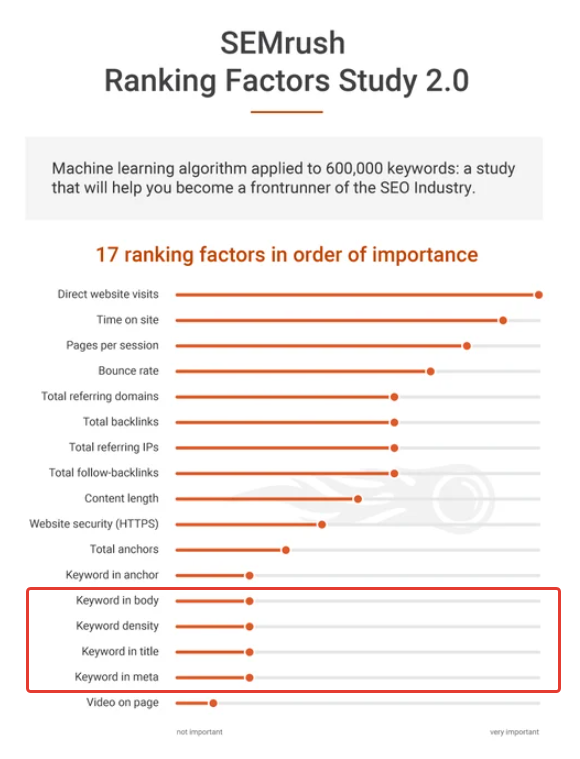SEO is not all blood magic with formulas and enchantments. The difficulty with SEO is that you can work for days and not really see any direct influence on your rankings. You build new backlinks without seeing the impact.
Or you improve the architecture, the speed, and the internal linking and still detect no change. And the same goes for content changes. You rarely get a wow effect from isolated actions in SEO, and it can be frustrating.
But when you look back at all those days of work, you probably realize that over time, more keywords started ranking, the average rank per keyword improved, and traffic improved. SEO does work in mysterious ways, but there is one equation that often holds: the correlation between the time you spend on your SEO and the improvements you make in ranking.

One secret formula for SEO is that the more improvements you make on your content, your site architecture, and your authority (in the form of backlinks and brand recognition), the better your rank in search results. Image source: Author
Overview: What is on-page SEO?
On-page optimization is a pillar of SEO architecture, along with things like site speed and internal linking. There are two basic concepts to focus on for on-page SEO:
- Prominence: The appearance of keywords in important places, like titles and early in content blocks.
- Density: The number of times keywords or synonyms appear within the content block.
For local SEO, one more optimization is important: the consistent use of your business name, address, and phone number throughout the site.
Onsite SEO was the high-priority area in the early days of search engine optimization. Some consultants still primarily work on improving site architecture in the hope it will influence their rankings, but most experts agree that deploying on-page SEO techniques is not nearly enough to make a site rank for your keywords.
In the SEMrush ranking factors study from 2017, most on-page optimization was ranked lower than user experience and off-site factors.

SEMrush found that on-page SEO techniques had less importance for ranking than user experience and backlinks. Image source: Author
Source: SEMrush.com.
5 most important on-page SEO factors
Search engines crawl and rank sites differently, and their algorithms evolve to take more and more factors into account. It is generally agreed that placing keywords prominently and having a relatively high density of keywords and synonyms is important. Let's look at the most important on-page SEO factors.
1. Keyword in title tag
The title tag is in the head section of a webpage, one of the first lines of code in a document. The title tag is the page title shown in the browser window but not inside the page itself. Having your keyword in the title tag is considered essential for SEO.
2. Keyword in H1 tag
H1 (short for Heading 1) tags are HTML markup for the biggest title in a document. It is placed in the body section of a webpage and is a large title visible to the reader. Having your keyword in an H1 tag is considered important for SEO.
3. Keyword early in content
Most search engines index entire webpages from start to end. But this takes up a lot of memory and disk space, so some store and index only the beginning of the page. A keyword in the first 100 to 200 characters of a page is considered important for ranking. It signals that the word is important for the content, and it guarantees that the keyword is in the indexed part of your page.
4. Keyword repetitions in content
If a piece of content covers a topic, the main keywords will naturally be repeated several times in the text. To rank for a keyword, it is important that the word appears frequently in the text. With the evolution of search engine algorithms, simple repetition is becoming less important. It is being replaced by a need to cover synonyms and different forms of the keywords within the text.
5. Keyword in meta description
Most search engines don't count content in the meta description tag as part of the page they analyze. The meta description is mainly used for showing what the page is about in search results pages. If the keyword appears in the meta description, it will be highlighted and make the result more appealing. That is the main reason why it is still important to write meta descriptions for your site.
How to optimize your on-page SEO
Now that we have seen the importance of your page architecture, we are ready to address how to optimize SEO within your site.
1. Keyword-page pairing
To connect keywords to pages, we assume you have already done in-depth keyword research. From your keyword research, extract your list of target keywords and the search volume for each of them. Inside your site structure, you should now decide what pages you would like to rank for each of your target keywords.
Make a list of those keyword-to-page pairs. Often the hardest keyword is paired with the strongest page, the homepage. You can use one of the leading SEO tools to identify pages already ranking for certain keywords.
A good way to keep track of your keyword-to-page pairs is by creating a spreadsheet for the purpose. You can name the document On-Page SEO. You can add column labels with the following names: Target Keyword, Search Volume, Target URL, Title, H1 Title, Description. Fill in the Target Keyword and Search Volume from your keyword research and now find the Target URL for each of the keywords you want to target.
2. Preparing titles and descriptions per page
Now you must work hard on your titles and descriptions. You need a page title, a slightly different H1 title, and a meta description of a few lines. The keyword for the page must appear in each element in a natural way.
For the title tag, try placing the keyword toward the beginning of the line for a better effect. You can work through the spreadsheet you created line by line to complete the work. Remember to spellcheck and proofread once you have finished.
3. Implementing page structure changes
How you implement your changes depends on the way you manage your website. Changes to the head section of your documents typically require updates via the CMS. This applies to the title and meta tags. With your title and meta descriptions in hand, discuss the best way to implement the changes with your developer, or check the documentation for the CMS you are using to do it yourself.
4. Keyword-enriching content
The content of your site is typically easier to access. This is where you will place your H1 title and keywords in the content. You may have to verify that H1 tags are placed around your page titles inside your page code.
After you have updated the title, verify that the target keyword is mentioned at the beginning of the content -- rewrite the opening paragraph if needed. Then search for the keyword in the document to see where it appears.
Start reading through the content thoroughly to identify places where you can rewrite phrases to make them more keyword-rich, including not just your target keyword, but also variations and synonyms for it.
5. Check for best practices
Once all your keywords have been used to optimize pages on your site and the technical implementation is in place, you should be able to see the changes in search engines. After you have finished implementing all the changes, you might need to resubmit your site to search engines and wait for the changes to appear.
When your site has been re-indexed, you can run a new site crawl with an SEO tool to show the changes. Now, for each of your URLs, run through the on-page SEO checklist below to finalize your on-page optimization:
- Keyword appears in the title tag
- Keyword appears in the meta description
- Keyword appears in the H1 tag
- Keyword is placed at the beginning of the content
- Keyword, variations, and synonyms are repeated throughout the content
Your on-page optimization empowers other SEO actions
With your pages optimized and keyword-rich, any other SEO improvements you do will benefit from the strong performance of your enhanced pages. It is a time-consuming process to go through, but fortunately, you really have to do this only once for your site.
Afterward, make sure your new content is optimized as it is published and shift your focus to improving other parts of your SEO, such as your server response time and your backlinks.
Our Small Business Expert
We're firm believers in the Golden Rule, which is why editorial opinions are ours alone and have not been previously reviewed, approved, or endorsed by included advertisers. The Ascent, a Motley Fool service, does not cover all offers on the market. The Ascent has a dedicated team of editors and analysts focused on personal finance, and they follow the same set of publishing standards and editorial integrity while maintaining professional separation from the analysts and editors on other Motley Fool brands.